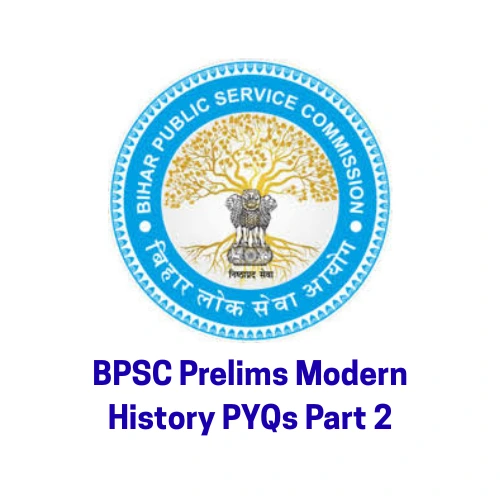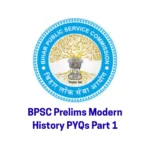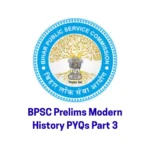Modern Indian History carries significant weight in the BPSC Prelims exam. The questions mainly revolve around the European arrival in India to the Independence movement. BPSC Prelims Modern History PYQs Part 2 highlight key personalities, major struggles, and socio-political transformations.
- Entry of Europeans – French, and British; their trading rivalry and battles.
- British Rule & Policies – Subsidiary Alliance, Doctrine of Lapse, and economic impact.
- Social & Religious Reforms – Contributions of reformers Swami Vivekananda, Dayananda Saraswati.
- Peasant and Tribal Uprisings – Santhal Revolt, Munda Uprising, and similar struggles.
- Revolt of 1857 – Causes, leaders, spread, and Bihar’s contribution through Kunwar Singh.
- Freedom Struggle – Role of Swadeshi and Home Rule, Non-Cooperation, Civil Disobedience, Quit India.
- Revolutionary & Military Efforts – Activities of revolutionaries, HSRA, INA, and Subhas Chandra Bose.
- Bihar’s Contribution – Champaran Satyagraha, Quit India movement in Bihar, and regional leaders.
BPSC Prelims Modern History PYQs Part 2
Under the Royal Titles Act, Queen Victoria became the empress of India in:
(a) 1875
(b) 1874
(c) 1877
(d) 1876
Ans: (c) 1877
Who among the following Indian capitalists was not the architect of the “Bombay Plan”?
(a) Dhirubhai Ambani
(b) J. R. D. Tata
(c) Sri Ram
(d) G. D. Birla
Ans: (a) Dhirubhai Ambani
Who headed the Royal Commission on Indian Currency appointed in 1913?
(a) James Wilson
(b) J. M. Keynes
(c) Sir Austin Chamberlain
(d) Sir W. R. Mansfield
Ans: (c) Sir Austin Chamberlain
Which of the following was not one of the features of the Government of India Act, 1935?
(a) Reconstruction of the Governor-General’s Executive Council
(b) Provincial Autonomy
(c) Appraisal of the Act of 1935
(d) Proposal for Federation of India
Ans: (c) Appraisal of the Act of 1935
During the Quit India Movement a parallel ‘National Government’ was established at many places. Which of the following is not correctly matched?
(a) Raiyati Sarkar – Kheda (Gujarat)
(b) Prati Sarkar – Satara (Maharashtra)
(c) Praja Mandal – Talchar (Orissa)
(d) Jatiy Sarkar – Tamluk (Bengal)
Ans: (a) Raiyati Sarkar – Kheda (Gujarat)
Modern History Previous Year Paper
To highlight the hardships faced by the peasants, Sahajanand Saraswati published which newspaper?
(a) Lok Sangraha
(b) The Broken Wing
(c) Indian Nation
(d) Nirbal Sevak
Ans: (a) Lok Sangraha
Who was the founder of the Farazi Movement?
(a) Haji Shariatullal
(b) Sayyid Ahmad
(c) Dudhu Mian
(d) More than one of the above
Ans: (a) Haji Shariatullal
Who wrote “New Lamps For The Old” ?
(a) Surendranath
(b) Aurobindo Ghosh
(c) Motilal Ghosh
(d) More than one of the above
Ans: (b) Aurobindo Ghosh
Ramkrishna Mission was founded by:
(a) Vidyasagar in 1899
(b) Swami Vivekanand in 1899
(c) Swami Vivekanand in 1897
(d) More than one of the above
Ans: (c) Swami Vivekanand in 1897
Consider the following statements regarding Wood’s Dispatch of 1854:
It recommended English as the medium of instruction for higher studies.
It laid stress on female education and vocational training.
Which of the above statements is/are correct?
(a) Only 1
(b) Only 2
(c) Both 1 and 2
(d) Neither 1 nor 2
Ans. (c) Both 1 and 2
BPSC Prelims Modern History PYQs Part 2
Which of the following statements about the Vernacular Press Act is/are correct?
It was enacted by Lord Lytton.
It came to be known as a ‘Gagging Act’.
The Act was repealed by Lord Ripon.
Select the correct answer using the codes given below.
(a) Only 1 and 2
(b) Only 2 and 3
(c) Only 1
(d) 1, 2 and 3
Ans. (d) 1, 2 and 3
Which of the following statements about Lord Mayo’s Resolution of 1870 are correct?
It was the first step that bifurcated Central and Provincial finances.
Provincial Governments were empowered to administer certain services.
It attempted to rectify existing imparity.
It focussed on the actual needs of the Provinces.
Select the correct answer using the codes given below.
(a) Only 1 and 2
(b) Only 1, 3 and 4
(c) Only 2, 3 and 4
(d) 1, 2, 3 and 4
Ans. (d) 1, 2, 3 and 4
Which of the following were the reasons for the failure of the Revolt of 1857?
The military superiority of the British
The rebels did not have a unified programme and ideology
There was a lack of support from all the sections of society
Select the correct answer using the codes given below.
(a) Only 1 and 2
(b) Only 2 and 3
(c) All of the above
(d) None of the above
Ans. (c) All of the above
Modern History Previous Year Paper
Consider the following events during India’s Freedom Struggle:
Home Rule Movement
Surat Split
Kheda Satyagraha
Minto-Morley Reforms
Which of the following is the correct chronological order of the events given above?
(a) 1-3-2-4
(b) 2-4-1-3
(c) 1-4-2-3
(d) 2-3-1-4
Ans. (b) 2-4-1-3
Lord Lytton is not associated with which of the following?
(a) The Strachey Commission
(b) The Arms Act
(c) The Vernacular Press Act
(d) The Ilbert Bill
Ans. (d) The Ilbert Bill
In which of the following movements did Mahatma Gandhi make the first use of the hunger strike as a weapon?
(a) Non-Cooperation Movement
(b) Bardoli Satyagraha
(c) Ahmedabad Strike
(d) Rowlatt Satyagraha
Ans. (c) Ahmedabad Strike
Match List-I with List-II:
A. Servants of India Society 1. Debendranath Tagore B. Tattwabodhini Sabha 2. Gopal Krishna Gokhale C. Atmiya Sabha 3. Ram Mohan Roy 4. Keshab Chandra Sen
Select the correct answer using the codes given below.
A B C
(a) 2 1 3
(b) 2 4 3
(c) 1 2 3
(d) 1 4 3
Ans. (a) 2 1 3
BPSC Prelims Modern History PYQs Part 2
Ambabai, a woman freedom fighter, belonged to which of the following States of India?
(a) Kerala
(b) Andhra Pradesh
(c) Karnataka
(d) Madhya Pradesh
Ans. (c) Karnataka
Who among the following was not a member of the Cabinet Mission?
(a) P. Lawrence
(b) A. V. Alexander
(c) J. Andrew
(d) None of them
Ans. (c) J. Andrew
“The Indian National Congress was founded on the basis of safety valve theory, to protect the British Government from threats.” Which leader said that?
(a) C. Rajagopalachari
(b) Lala Lajpat Rai
(c) Bipin Chandra Pal
(d) None of them
Ans. (b) Lala Lajpat Rai
In which of the following Indian National Congress Sessions, the resolutions related to the Fundamental Rights were passed for the first time?
(a) Surat Session-1907
(b) Gaya Session-1922
(c) Karachi Session-1931
(d) None of the above
Ans. (c) Karachi Session-1931
The Swadeshi and Boycott were adopted as the methods of struggle for the first time during the
(a) Home Rule Movement.
(b) Visit of the Simon Commission to India.
(c) Partition of Bengal
(d) More than one of the above
(e) None of the above
Ans. (c) Partition of Bengal
Modern History Previous Year Paper
At the Calcutta Session of the Indian National Congress (INC) held in 1906, the Flag of Swaraj for India was unfurled by
(a) G.K Gokhale
(b) A.O Hume
(c) Dadabhai Naoroji
(d) More than one of the above
(e) None of the above
Ans. (c) Dadabhai Naoroji
During the freedom struggle, a parallel movement launched in the Indian States (in the States ruled by the Indian rulers such as Kashmir, Nizam’s Hyderabad, Travancore, etc) was
(a) State People’s Movement.
(b) Praja Mandal Movement
(c) Swaraj Movement
(d) More than one of the above
(e) None of the above
Ans. (b) Praja Mandal Movement
Which of the following statements are not correct regarding the Non-Cooperation Movement in the towns?
Only the upper caste and the rich took part in the movement.
The council elections were boycotted even by the Justice Party of Madras.
Thousands of students left government controlled schools, headmasters and teachers resigned and lawyers gave up their practice.
(a) 1 and 3 only
(b) 2 and 3 only
(c) 1 and 2 only
(d) More than one of the above
(e) None of the above
Ans. (c) 1 and 2 only
Which one of the following was journal brought out by Abul Kalam Azad?
(a) The Comrade
(b) Al-Hilal
(c) Zamindar
(d) More than one of the above
(e) None of the above
Ans. (b) Al-Hilal
Which of the following statements regarding the Indian Freedom struggle is not correct?
(a) Gandhiji withdrew from the Non Co-operation Movement due to the Chauri-Chaura incident.
(b) Gandhiji gave his first major public speech at Banaras Hindu University.
(c) Mahatma Gandhi was arrested in the year 1921.
(d) More than one of the above
(e) None of the above
Ans. (c) Mahatma Gandhi was arrested in the year 1921.
BPSC Prelims Modern History PYQs Part 2
How did the study of history help in creating a feeling of nationalism in India towards the end of the
19th century?
(a) By reinterpreting history and refuting the British portrayal of Indians as backward primitive and incapable of governing themselves.
(b) By writing about India’s glorious past and urging people to take pride in their achievements.
(c) By urging people to struggle and change the miserable conditions of life under the British rule.
(d) More than one of the above
(e) None of the above
Ans. (d) More than one of the above
Who was the founder of All India Harijan Sangh in 1932?
(a) Jagjivan Ram
(b) Mahatma Gandhi
(c) Dr. B.R. Ambedkar
(d) More than one of the above
(e) None of the above
Ans. (b) Mahatma Gandhi
On 20th February, 1947, Prime Minister Attlee announced the British Government’s decision to withdraw from India latest by
(a) August, 1947
(b) January, 1948
(c) June, 1948
(d) More than one of the above
(e) None of the above
Ans. (c) June, 1948
Who among the following headed the two Boundary commissions set up to delineate the International frontiers between India and Pakistan in 1947?
(a) A.P Moon.
(b) A.V Alexander
(c) Cyril Radcliffe
(d) More than one of the above
(e) None of the above
Ans. (c) Cyril Radcliffe
Modern History Previous Year Paper
Who introduced the system of Mahalwari Settlement in Bengal?
(a) Lord Cornwallis
(b) Holt Mackenzie
(c) Lord Hastings
(d) More than one of the above
(e) None of the above
Ans. (b) Holt Mackenzie
In 1940, Vinoba Bhave started Individual Satyagraha from
(a) Nadiad in Kheda district, Gujarat.
(b) Pavnar, Maharashtra
(c) Punnapra-Vayalar, Kerala
(d) More than one of the above
(e) None of the above
Ans. (b) Pavnar, Maharashtra
The Congress took a critical stand over the Montford Reforms in 1918, which led to break up with the old moderate remnants (Sapru, Jayakar and Chintamani) who formed the
(a) Servants of India Society
(b) Swaraj Party
(c) Indian National Liberal Federation.
(d) More than one of the above
(e) None of the above
Ans. (c) Indian National Liberal Federation.


